| Listing 1 - 10 of 30 | << page >> |
Sort by
|
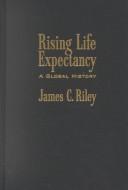
ISBN: 0521802458 0521002818 1316036499 9781316036495 Year: 2001 Publisher: Cambridge : Cambridge University Press,
Abstract | Keywords | Export | Availability | Bookmark
 Loading...
Loading...Choose an application
- Reference Manager
- EndNote
- RefWorks (Direct export to RefWorks)
Between 1800 and 2000 life expectancy at birth rose from about 30 years to a global average of 67 years, and to more than 75 years in favored countries. This dramatic change, called the health transition, is characterized by a transition both in how long people expected to live, and how they expected to die. The most common age at death jumped from infancy to old age. Most people lived to know their children as adults, and most children became acquainted with their grandparents. Whereas earlier people died chiefly from infectious diseases with a short course, by later decades they died from chronic diseases, often with a protracted course. The ranks of people living in their most economically productive years filled out, and the old became commonplace figures everywhere. Rising Life Expectancy: A Global History examines the way humans reduced risks to their survival, both regionally and globally, to promote world population growth and population aging.
Sociology of health --- World history --- anno 1800-1999 --- Life expectancy. --- Geschiedenis van opvoeding en onderwijs --- handboeken en inleidingen --- handboeken en inleidingen. --- Life expectancy --- Expectancy of life --- Expectation of life --- Life spans (Biology) --- Vital statistics --- Premature death --- ESPERANCE DE VIE --- DEMOGRAPHIE --- HISTOIRE --- DISCOURS, ESSAIS, CONFERENCES
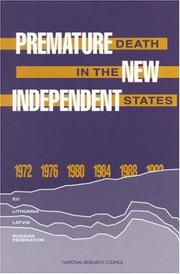
ISBN: 0309057345 0309524504 0585039461 9780585039466 9780309057349 9780309524506 0309174937 9780309174930 Year: 1997 Publisher: Washington, D.C. : National Academy Press,
Abstract | Keywords | Export | Availability | Bookmark
 Loading...
Loading...Choose an application
- Reference Manager
- EndNote
- RefWorks (Direct export to RefWorks)
Premature death --- Mortality --- Life expectancy --- Preventive health services --- Demography --- Business & Economics --- Expectancy of life --- Expectation of life --- Mortality, Law of --- Life spans (Biology) --- Vital statistics --- Death --- Death (Biology) --- Premature death - Former Soviet republics - Congresses. --- Mortality - Former Soviet republics - Congresses. --- Life expectancy - Former Soviet republics - Congresses. --- Preventive health services - Former Soviet republics - Congresses.
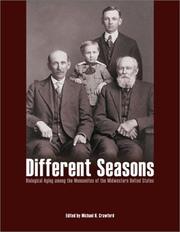
ISBN: 093833221X 9780938332213 Year: 2000 Volume: 21 Publisher: Lawrence University of Kansas. Department of anthropology
Abstract | Keywords | Export | Availability | Bookmark
 Loading...
Loading...Choose an application
- Reference Manager
- EndNote
- RefWorks (Direct export to RefWorks)
Aging --- Mennonites --- Life expectancy --- Anabaptists --- Baptists --- Christian sects --- Expectancy of life --- Expectation of life --- Life spans (Biology) --- Vital statistics --- Premature death --- Age --- Ageing --- Senescence --- Developmental biology --- Gerontology --- Longevity --- Age factors in disease --- Physiological effect --- Aging - United States - Statistics. --- Mennonites - United States - Statistics. --- Life expectancy - United States - Statistics.

ISBN: 128060736X 9786610607365 9264035885 9789264035881 9264035877 Year: 2006 Publisher: Paris OECD
Abstract | Keywords | Export | Availability | Bookmark
 Loading...
Loading...Choose an application
- Reference Manager
- EndNote
- RefWorks (Direct export to RefWorks)
This report helps establish a new agenda for age-friendly employment policies and practices. It sets out the policy challenges presented by rapidly ageing labour forces in OECD countries and draws out the main lessons learned from OECD's series of country reviews on Ageing and Employment policies. Among other issues, it discusses how to remove work disincentives and increase choice in the work-retirement decision, improve employability of older workers, and change employer attitudes and employment practices.
Age and employment. --- Health promotion. --- Life expectancy. --- Older people -- Employment. --- Age and employment --- Life expectancy --- Older people --- Business & Economics --- Labor & Workers' Economics --- Employment --- Employment. --- Expectancy of life --- Expectation of life --- Employment and age --- Older unemployed --- Life spans (Biology) --- Vital statistics --- Premature death --- Employment (Economic theory) --- Ability, Influence of age on --- Child labor --- Post-retirement employment
Book
ISBN: 0226407942 Year: 1976 Publisher: Chicago (Ill.) University of Chicago press
Abstract | Keywords | Export | Availability | Bookmark
 Loading...
Loading...Choose an application
- Reference Manager
- EndNote
- RefWorks (Direct export to RefWorks)
Life expectancy --- Life insurance --- Safety regulations --- Uncertainty --- 06.04.a.USA --- Reasoning --- Insurance, Life --- Insurance --- Viatical settlements --- Expectancy of life --- Expectation of life --- Life spans (Biology) --- Vital statistics --- Premature death --- Safety regulations, International --- Accidents --- Police regulations --- Industrial safety --- Cost effectiveness --- Levensverzekering ; Algemeen ; Verenigde Staten --- Prevention --- Law and legislation --- Demography --- Public economics
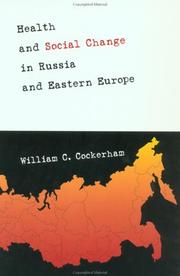
ISBN: 9786610407453 1135963223 128040745X 0203905237 0203906470 9780203906477 9780203905234 9780415920803 0415920809 9780415920810 0415920817 6610407452 9781135963224 9781280407451 9781135963170 9781135963217 1135963215 Year: 1999 Publisher: New York Routledge
Abstract | Keywords | Export | Availability | Bookmark
 Loading...
Loading...Choose an application
- Reference Manager
- EndNote
- RefWorks (Direct export to RefWorks)
Health --- Social medicine --- Life expectancy --- Mortality --- Mortality, Law of --- Death --- Demography --- Death (Biology) --- Expectancy of life --- Expectation of life --- Life spans (Biology) --- Vital statistics --- Premature death --- Personal health --- Wellness --- Medicine --- Physiology --- Diseases --- Holistic medicine --- Hygiene --- Well-being --- Medical care --- Medical sociology --- Medicine, Social --- Public health --- Public welfare --- Sociology --- Medical ethics --- Medical sociologists --- Social aspects
Book
ISBN: 9783515112581 3515112588 9783515112758 3515112758 Year: 2016 Publisher: Stuttgart Franz Steiner Verlag
Abstract | Keywords | Export | Availability | Bookmark
 Loading...
Loading...Choose an application
- Reference Manager
- EndNote
- RefWorks (Direct export to RefWorks)
It was not until the 1850s that the average life expectancy in women began to rise noticeably in Germany and Europe. Up to the 1980s it increased in waves. Since then the gender gap has gradually decreased and settled. For decades demographers, historians, medical researchers and health scientists have provided partial explanations for this phenomenon. This volume now presents a comparison of seven Central, Western and Northern European countries spanning one and a half centuries: some of the selected countries took part in both World Wars, others remained neutral; in some countries the rate of smoking varies, others have widely differing female occupation rates. As a result of this comparison, the varying effects of biological and socio-cultural influences on the gender gap and the reversal of this secular trend can be placed with much greater scientific precision than before. The volume also contributes to objectify the public debate on the gender gap and its implications for health policy.
Life expectancy --- Expectancy of life --- Expectation of life --- Life spans (Biology) --- Vital statistics --- Premature death --- Sex differences --- History. --- (Produktform)Electronic book text --- Gender-Specific Life Expectancy --- Medizingeschichte --- gender gap --- (VLB-WN)9550 --- Life Expectancy --- Sex Factors. --- History, 20th Century. --- History, 21st Century. --- Espérance de vie --- history. --- History --- Différences entre sexes --- Histoire --- Europe.
Book
ISBN: 1281250872 9786611250874 3540785205 3540785191 3642097278 Year: 2008 Volume: 1613-5520 Publisher: Berlin, Heidelberg : Springer Berlin Heidelberg : Imprint: Springer,
Abstract | Keywords | Export | Availability | Bookmark
 Loading...
Loading...Choose an application
- Reference Manager
- EndNote
- RefWorks (Direct export to RefWorks)
The most widely used measure of longevity is the period life expectancy at birth which is calculated from age specific death rates by life table methods. In 2002, John Bongaarts and Griffith Feeney introduced the revolutionary idea that this conventional estimate of period life expectancy is distorted by a tempo effect whenever longevity is changing. The tempo effect is defined as an inflation or deflation of the period incidence of a demographic event resulting from a rise or fall in the mean age at which the event occurs. Some demographers agree with this radical argument; others disagree. The book reviews the debate on how best to measure period longevity. In the various chapters, leading experts in demography critically examine the existence of the tempo effect in mortality, present extensions and applications, and compare period and cohort longevity measures. The book provides a deeper understanding of and new insights into the fundamental question "How long do we live"?
Life expectancy --- Mathematical models. --- Expectancy of life --- Expectation of life --- Life spans (Biology) --- Vital statistics --- Premature death --- Demography. --- Population. --- Aging --- Statistics. --- Population Economics. --- Aging. --- Statistics for Social Sciences, Humanities, Law. --- Research. --- Statistical analysis --- Statistical data --- Statistical methods --- Statistical science --- Mathematics --- Econometrics --- Age --- Ageing --- Senescence --- Developmental biology --- Gerontology --- Longevity --- Age factors in disease --- Human population --- Human populations --- Population growth --- Populations, Human --- Economics --- Human ecology --- Sociology --- Demography --- Malthusianism --- Historical demography --- Social sciences --- Population --- Physiological effect --- Statistics .
Book
ISBN: 9811066299 9811066280 Year: 2018 Publisher: Singapore : Springer Singapore : Imprint: Springer,
Abstract | Keywords | Export | Availability | Bookmark
 Loading...
Loading...Choose an application
- Reference Manager
- EndNote
- RefWorks (Direct export to RefWorks)
This book is the first one to examine the cause and effect of elderly people’s healthy life expectancy, providing models that are easy to understand. The novel point is the success achieved in constructing a single structural model of cause and effect of healthy life expectancy. In the final models of the authors’ studies, it was possible to clearly point out that it is not the case that lifestyle habits including an ideal diet directly provide for healthy life expectancy. This book is made up of published studies based on scientific evidence, using a vast amount of data based on about 8,000 in-home elderly people tracked longitudinally from 3 to 6 years, three times in all including baseline research, in a specific region of Japan. Therefore, health policy makers will be able to use this book as scientific evidence for creating area programs to promote good health that are focused on healthy longevity as the central issue. Academic researchers whose special fields are mainly public health will be able to learn both theory and practice to structurally analyze cause and effect of health factors.
Life expectancy --- Expectancy of life --- Expectation of life --- Life spans (Biology) --- Vital statistics --- Premature death --- Aging --- Geriatrics. --- Quality of Life --- Aging. --- Geriatrics/Gerontology. --- Quality of Life Research. --- Life, Quality of --- Economic history --- Human ecology --- Life --- Social history --- Basic needs --- Human comfort --- Social accounting --- Work-life balance --- Medicine --- Gerontology --- Older people --- Age --- Ageing --- Senescence --- Developmental biology --- Longevity --- Age factors in disease --- Research. --- Diseases --- Health and hygiene --- Physiological effect --- Medical research. --- Biomedical research --- Medical research
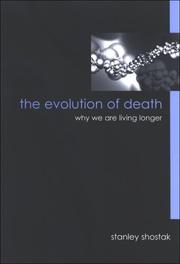
ISBN: 079148081X 1429413573 9781429413572 079146945X 0791469468 9780791469453 9780791469460 9780791480816 Year: 2006 Publisher: Albany : State University of New York Press,
Abstract | Keywords | Export | Availability | Bookmark
 Loading...
Loading...Choose an application
- Reference Manager
- EndNote
- RefWorks (Direct export to RefWorks)
In The Evolution of Death, the follow-up to Becoming Immortal: Combining Cloning and Stem-Cell Therapy, also published by SUNY Press, Stanley Shostak argues that death, like life, can evolve. Observing that literature, philosophy, religion, genetics, physics, and gerontology still struggle to explain why we die, Shostak explores the mystery of death from a biological perspective.Death, Shostak claims, is not the end of a linear journey, static and indifferent to change. Instead, he suggests, the current efforts to live longer have profoundly affected our ecological niche, and we are evolving into a long-lived species. Pointing to the artificial means currently used to prolong life, he argues that as we become increasingly juvenilized in our adult life, death will become significantly and evolutionarily delayed. As bodies evolve, the embryos of succeeding generations may be accumulating the stem cells that preserve and restore, providing the resources necessary to live longer and longer. If trends like this continue, Shostak contends, future human beings may join the ranks of other animals with indefinite life spans.
Life Expectancy --- Evolution. --- Aging. --- Death. --- Life expectancy. --- Expectancy of life --- Expectation of life --- Life spans (Biology) --- Vital statistics --- Premature death --- Death --- Dying --- End of life --- Life --- Terminal care --- Terminally ill --- Thanatology --- Age --- Ageing --- Senescence --- Developmental biology --- Gerontology --- Longevity --- Age factors in disease --- Cardiac Death --- Determination of Death --- End Of Life --- End-Of-Life --- Near-Death Experience --- Death, Cardiac --- Fatal Outcome --- Aging, Biological --- Biological Aging --- Mutation Accumulation --- trends. --- Philosophy --- Physiological effect
| Listing 1 - 10 of 30 | << page >> |
Sort by
|

 Search
Search Feedback
Feedback About
About Help
Help News
News